Do you wish to make your relationships more intimate? Then understanding the social penetration theory can help you significantly in getting close to the people you care about.
What is the social penetration theory?
Developed by psychologists Irwin Altman and Dalmas Taylor, the social penetration theory or SPT focuses on the various ways a relationship grows, progresses, and becomes more intimate. It claims that interpersonal communication plays a crucial role in bringing two or more individuals closer and enriching a relationship by developing closeness.
The concept posits that with the development of a relationship, communication becomes more deeper and intimate, instead of being shallow and cold. In their 1973 research, Altman and Taylor state that relationships require and “involve different levels of intimacy of exchange or degree of social penetration.”

Being an objective theory, SPT reveals that interpersonal relationships grow mainly through deliberately revealing personal information about one’s self like personal values, motivations, experiences, intentions, thoughts, and emotions to another person they deem close. This is known as self-disclosure.
This psychological theory also assumes that relationships grow and progress in a predictable, yet systematic manner. Self-disclosure allows a relationship to develop by shifting from superficial layers of communication to more intimate exchanges. However, it can also explain how a relationship deteriorates and comes to an end.
Related: 3 Reasons Why Communication Is Crucial For Sustained Intimacy
Understanding social penetration theory
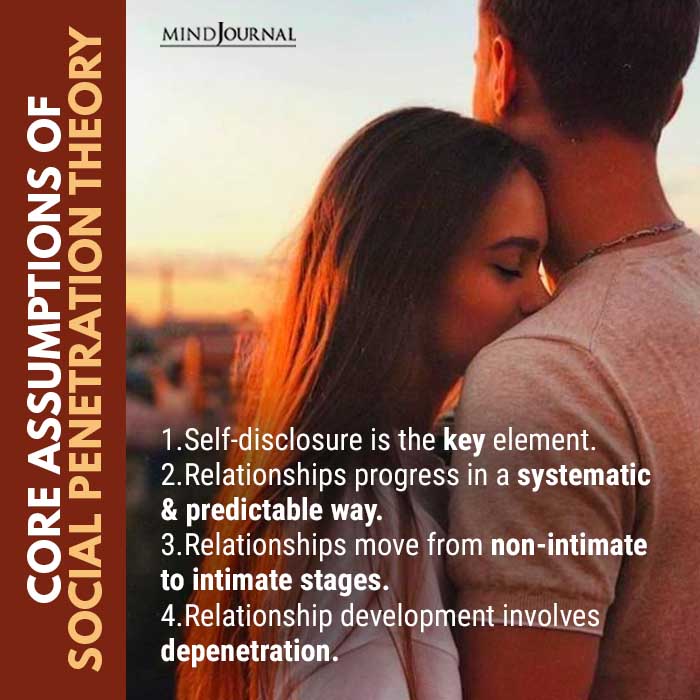
According to the Social Penetration Theory, if you wish to move your relationship from a non-intimate level to a more personal and deeper level, self-disclosure is key. According to Altman and Taylor’s theory, closeness and intimacy is a gradual process that is based on interpersonal communication, mutual self-disclosure, and exchanging vulnerabilities.
The researchers believed that social penetration occurs faster during the initial stages of a relationship. However, it slows down remarkably as the relationship grows old.
As it is, the concept is based on four core assumptions:
- Self-disclosure is the most important element of relational development.
- Relationships generally develop in a systematic, yet predictable manner.
- Interpersonal relationships move from non-intimate stages to intimate stages.
- Development of a relationship naturally involves depenetration & dissolution.
According to a 2015 study by researchers Amanda Carpenter and Kathryn Greene at Rutgers University in New Jersey, USA, “Social penetration theory describes the role of disclosure in relationship development, focusing specifically on how self‐disclosure functions in developing relationships.”
The study also mentions that the onion model of self-disclosure is used as a framework to explain penetration or closeness. “In developing relationships, people use self‐disclosure to increase intimacy including through breadth, depth, and the norm of reciprocity,” add Carpenter and Greene. It is also believed that penetration occurs through various stages and also involves rewards and costs.
Related: 9 Surprisingly Simple Secrets To Build A Happy and Emotionally Committed Relationship
The Onion Analogy
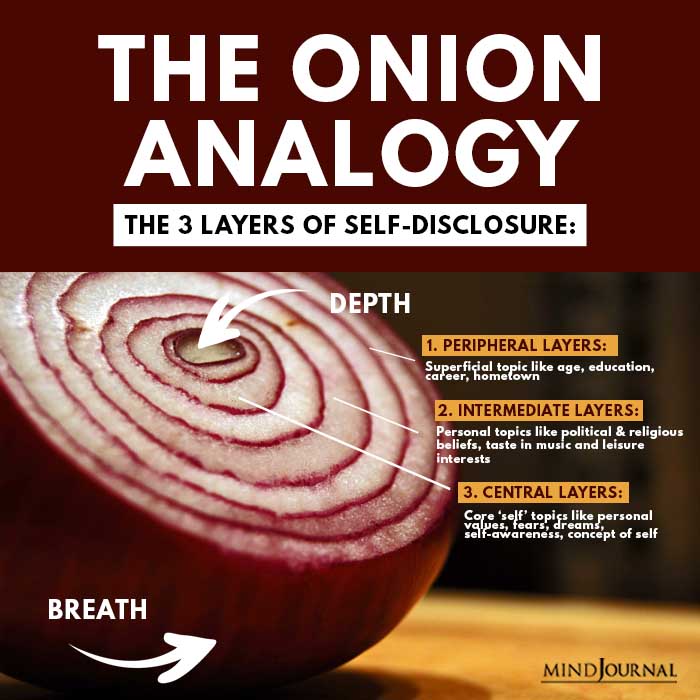
Self-disclosure was initially described as peeling the layers of an onion according to the social penetration theory by Altman and Taylor. This means self-disclosure includes both breadth and depth as we can find in an onion. In this context, breadth means the different aspects of ourselves and our lives, like our work, family, passions, dreams, goals, and community. Depth, on the other hand, deals with the intricate details related to these aspects of the self.
The Onion Analogy explains that human personality is like the multilayered onion. We have a superficial outer self, which we reveal to the public, like our jobs, gender, height, weight; and we have a deeper, more personal self, like our values, deep emotions, and concept of self, which we reveal only to our closest loved ones. As we choose to self-disclose to our partner or a close friend, we peel our outer layers and expose our core, inner layers which often makes us feel vulnerable.
This notion was developed in relation to the Social Penetration Theory to understand how much information we choose to reveal to someone. This also shows what role interpersonal communication and exchanging information plays in the growth and dissolution of relationships.
Along with breadth and depth, there are 3 separate layers in self-disclosure:
- Peripheral layer: Information related to age, education, career, hometown
- Intermediate layer: Information related to political & religious beliefs, taste in music, movies, books, extracurricular activities and leisure interests
- Central layer: Information related to personal values, fears, dreams, personality traits, self-awareness, self esteem, concept of self
The more we move closer towards the core, the deeper and more personal information we share which makes the relationship more intimate.
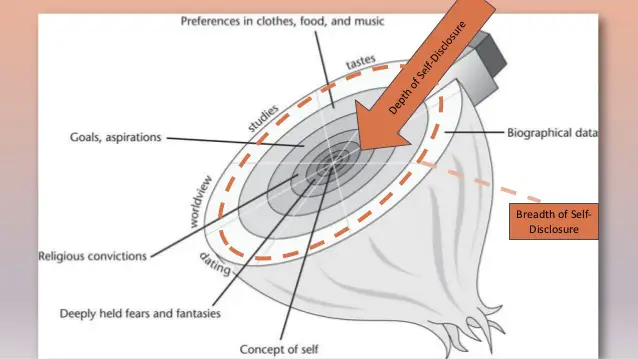
Stages of Self-Disclosure
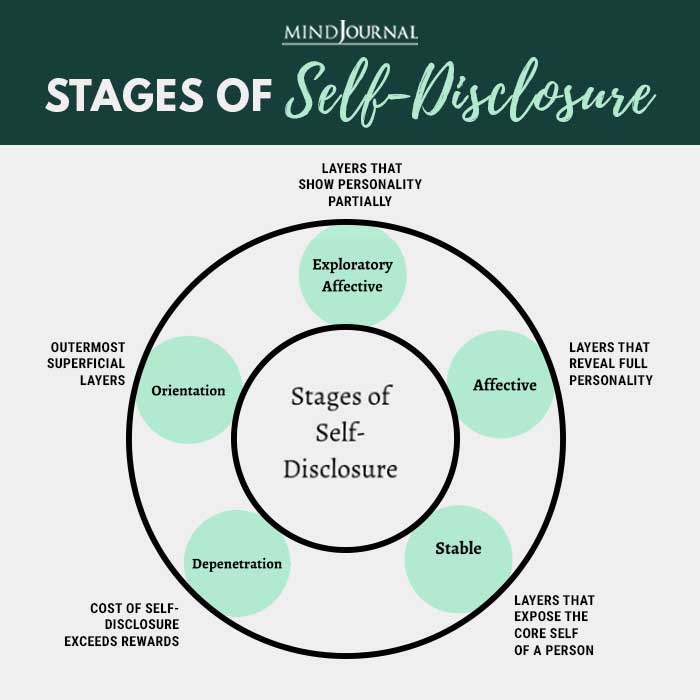
The Social Penetration Theory by Altman and Taylor comprises different stages which occur due to the self-disclosure process. These stages include:
- Orientation stage
- Exploratory affective stage
- Affective stage
- Stable stage
- Depenetration
Now let us take a closer look at each of these stages as it can help us understand how to implement the social penetration theory in our lives:
1. Orientation stage
This is the first stage when two people meet for the first time, introduce each other and engage mostly in small talk and create good first impressions. Here, we only reveal our most outer superficial layer. Communication largely revolves around observing body language, mannerisms, physical appearance, and the exchange of non-intimate information.
In a study, Amanda Carpenter and Kathryn Greene explain “In this initial stage, people are cautious and careful when disclosing information.” They add “people reveal bits of themselves at the public level and act in socially desirable and polite ways.”
Related: 12 Questions That Can Help Strengthen Your Relationship
2. Exploratory affective stage
As the relationship develops, more layers are exposed which allows our personality to show. This is done mostly through nonverbal and verbal communication. As we start disclosing more about ourselves, the relationship starts to become intimate. However, deep and personal information is mostly avoided and withheld. This is the level where most casual friendships form.
Carpenter and Greene write that in this stage people use less caution while communicating. “There may be an increase in the breadth of topics discussed, but these topics still generally reveal the public self. In this stage, the personality begins to emerge,” they add.
3. Affective stage
In this stage of SPT, communicators develop a deeper understanding of each other as more layers are peeled away. Here our complete personality is almost revealed to the other person. Communication involves personal topics and distinctive, more individualized mannerisms. In this stage, close friendships and romantic relationships begin to form and we become more comfortable criticizing or arguing with each other.
“In this stage, disclosure is casual and spontaneous, and this stage reflects further commitment and a level of comfort,” explained Carpenter and Greene. They add “The affective exchange stage may also include the initiation of conflict.”
4. Stable stage
In this stage, the communicators have reached the central layer and share everything with each other. The core of a person’s personality is exposed at this level. The relationship we share in this disclosure stage is open, honest, and comfortable. This stage is “characterized by openness, breadth, and depth across conversation topics,” writes Carpenter and Greene.
“The most intimate information about the private self is continuously disclosed at this stage. This stage is characterized by honesty and intimacy, a high degree of spontaneity, and open expression of thoughts, feelings, and behaviors,” they add. At this level, there are only a few relationships, mostly with romantic partners, best friends, and close family members.
5. Depenetration
This happens when we believe that the cost of self-disclosure is much more than the benefits it offers. As we withdraw and avoid self-disclosure, the relationship comes to an end. “Social depenetration, de‐escalation, or dissolution, is also possible when self‐disclosure is reduced as a result of interpersonal conflict and relational stressors,” explains Carpenter and Greene.
They write “Social depenetration is the deliberate closing off of some portions of a person’s life to his or her partner. This dissolution process can signal relationship disintegration or relationship renegotiation.” This signals a breakup or a divorce for romantic partners and friends drifting away from each other.
Related: Conflict Doesn’t Ruin a Relationship, a Lack of Connection Does
Assessing rewards and costs of self-disclosure
With self-disclosure comes vulnerability and with vulnerability comes some great costs. Hence, how much you decide to disclose about yourself to someone will entirely depend on the reward-cost assessment of the outcome. If the reward is more than the cost, then we will choose to share personal and intimate information. This can make sharing a more open and personal experience leading to a stronger relationship, better physical and emotional intimacy, and clearer communication with your partner.
However, when someone reacts negatively to the information we share and uses it to criticize and demean us, which can be common in an argument between romantic partners, then it can lead to feelings of mistrust, betrayal, manipulation. This is the result of why most couples separate and end their relationships. Disclosure will happen only when rewards exceed the cost.
According to an article published by the Oregon State University, “The decision to disclose is based on the perceived rewards the person will gain if he or she discloses information. If a person perceives that the cost of disclosing information is greater than the rewards for disclosing information then no information will be disclosed. The larger the reward-cost ratio the more disclosure takes place.”
Applying SPT in your life
If you want to implement social penetration theory in your life and relationships without making things overly complicated, then you need to focus on having both breadth and depth in information exchanges with your partner.
Breadth without depth will lead to a shallow relationship without any real emotional connection, while depth without breadth will affect the longevity of the connection and the relationship. Although it is possible to have a relationship with breadth without depth or depth without breadth.
However, it is crucial that you remember to progress through the process in a slow and steady manner. Remember the Onion Analogy? You need to peel away one layer at a time and expose your personality gradually to the other person. If you try to skip a few layers or speed through the process, then not only will you make the other person feel confused, you will also reach the depenetration stage sooner than you think.
If you wish to have both breadth and depth in disclosure in your relationships, then you and the other person need to develop your social and communication skills. Not only do you need to have the willingness and interest to open up, but you also need to know how to express yourself and talk to one another.
Related: 8 Ways To Better Understand Your Partner and Deepen Your Relationship
Develop closeness through self-disclosure
Social Penetration Theory offers an effective and comprehensible explanation of how important intimacy is in relationships and how we can use closeness to build stronger romantic relationships and friendships through self-disclosure.
“Self-disclosure can be a very useful skill, but only if employed properly,” explains Dr. Barbara LoFrisco, a licensed mental health counselor and family therapist. She believes that self-disclosure should be more about showing the other person how you can relate to their life experiences, instead of simply talking about you.
Barbara adds “Self-disclosure in therapy is when a therapist shares their own personal views or experience with a client with the purpose of improving the client’s emotional or mental state. It should be done solely for the purpose of helping the client, and not to meet the needs of the therapist.”
Now that you have a better idea about how SPT can help you and how you can use it in your own life, you will be better able to create more intimacy and build lasting relationships

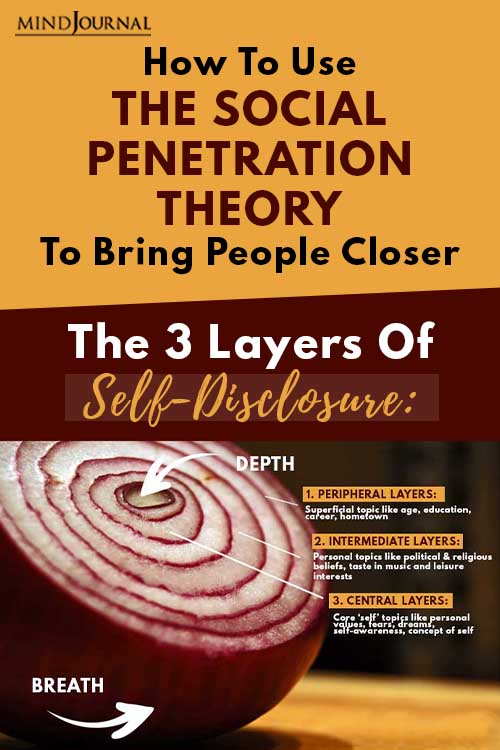
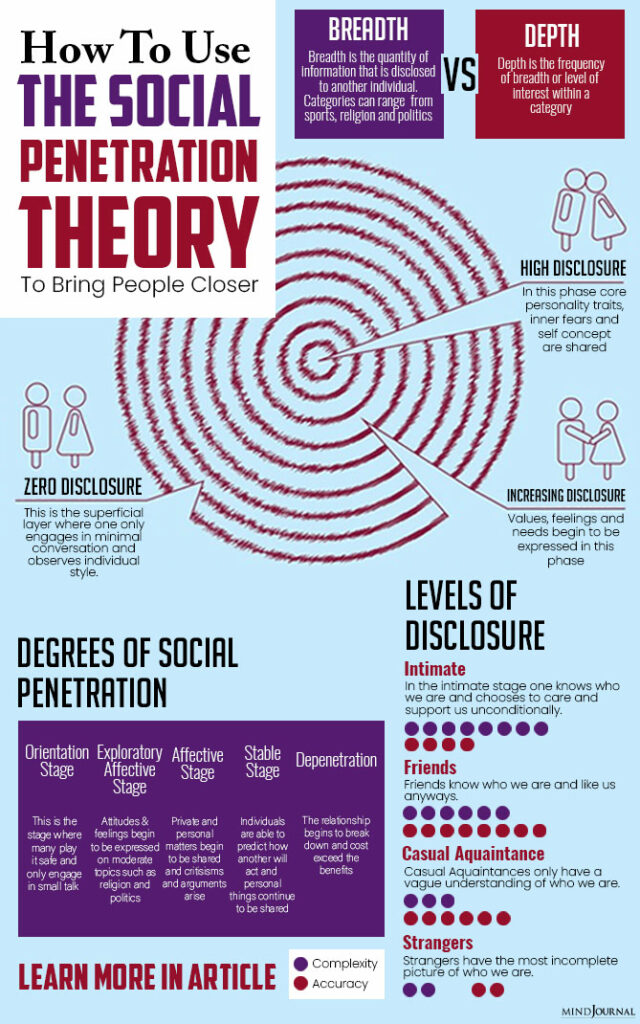
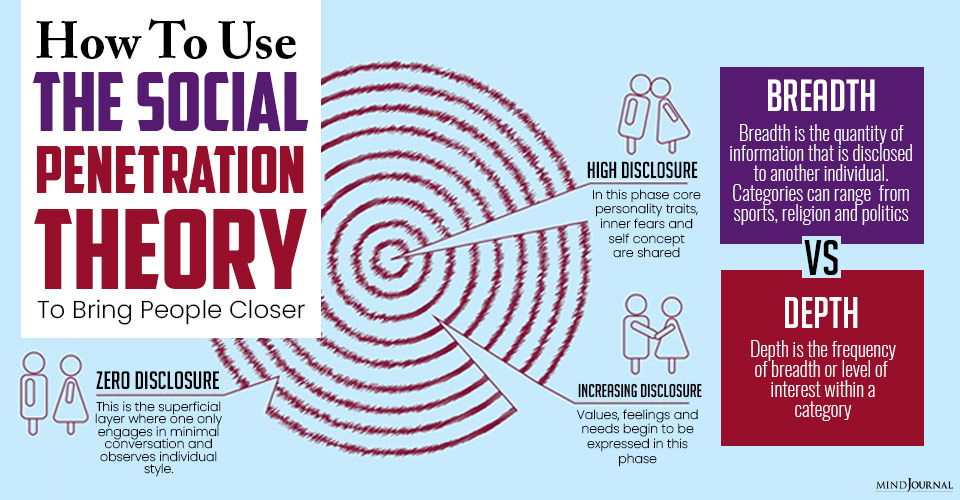







Leave a Reply
You must be logged in to post a comment.